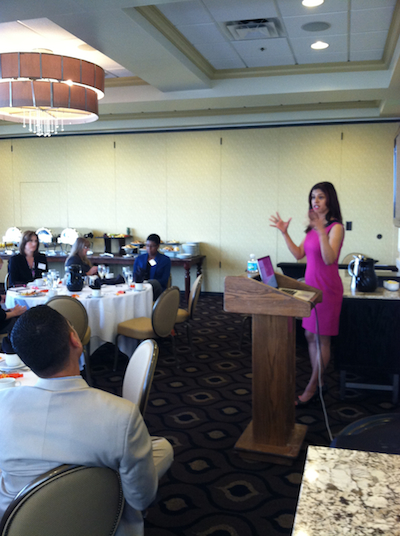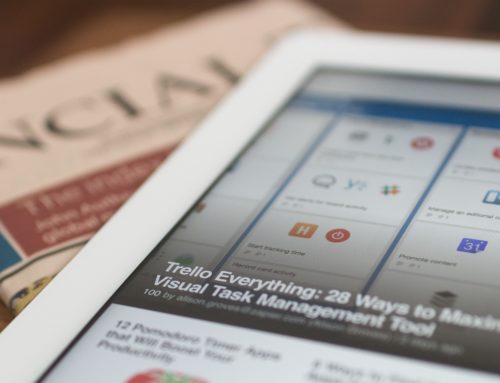 Last week I was in Orlando, Fla., speaking to the PRSA chapter on measurement. No, I didn’t go to Disney World, but I did have a terrific time.
Last week I was in Orlando, Fla., speaking to the PRSA chapter on measurement. No, I didn’t go to Disney World, but I did have a terrific time.
And I realized that while I speak and teach often on practical measurement for public relations, I haven’t really written about it here at WUL all that much. Not good. So here’s my approach. Especially if you have a small budget and don’t have access to fancy dashboards, then this might be helpful (and even if you do, it might still be helpful).
Before getting to that, though, I have a few don’ts:
Don’t
- get caught up in shiny new measurement tools. Because then you start trying to measure the tools, and not what you should be focusing on.
- get stuck just counting Twitter followers, Facebook fans, media impressions, yada yada. Note I said “just counting.”
- go crazy trying to find the one-size-fits-all measurement solution… because it doesn’t exist.
Now that you’ve read the don’ts, here’s what to do.
Typically, I undertake this very simple… ok, uncomplicated, five-step exercise:
1. Identify what the business objectives for your program/campaign are.
Based on these, what do you need people to do? For example, if your B.O. (not body odor!) is to increase sales, obviously you need them to buy more of your product/service, or more people to buy it, or both.
And while sales is one of the most common examples we use, they could be anything, based on your unique situation. For a nonprofit organization, for example, it might be to increase members of an online community… because those are the people it can start trying to convert into members/donors.
That last bit is what’s most important. That’s what you’re going to work backwards from, because while all roads might not lead to Rome, they should lead to that business objective.
Your business objective(s) should be at the core of your measurement program. So before you do anything else, figure them out.
2. Identify how you will measure the success or failure of these objectives.
For example, if your objective is to increase sales, what percentage do you want your sales to increase by over the last fiscal year (or whatever time period you choose)? Online or offline? Or both?
If your objective is to grow your email list (because that is where you convert the most prospects into customers), by how much do you want to do this? In what time frame?
Get as specific as you possibly can. This means not just quantifying what you’re trying to achieve, but identifying the timeframe within which you’re going to try to do this.
3. Now outline your communication strategy.
The most important thing here is to remember that you didn’t work out your strategy first. You looked at what the business objectives are, and then decided how you would use various communication and marketing vehicles to achieve those objectives.
And in order to do this, you must have an understanding of how your audience reacts to and uses different communication mediums. Because your program/campaign is probably going to be more effective if you include those mediums in your plan… right?
This means that you didn’t seize the shiny new toy du jour and say, “Oh, everyone’s on ____! We’re going to use _____!” Or: “Let’s make a viral video like Stop Kony!”
You don’t have to be everywhere all the time. Be where it makes the most sense.
4. Figure out how you’re going to track your efforts.
This is the part that is a lot of fun for me. With so many of our communications moving online, it’s possible to track a lot of things… and I mean a lot.
But don’t get caught in tracking nonsense numbers. I mean – going back to the “don’ts” above – you might get an ego boost out of seeing your Twitter followers grow, but if that growth isn’t helping you reach your business objectives… what’s the point, exactly?
Tracking URLs have become commonplace now. Use them. Get comfortable with Google Analytics and Google’s URL Builder. You will be amazed at how much insight these tools give you, particularly when it comes to understanding what is driving actions, clicks, downloads, purchases, sign-ups, etc.
And that helps inform your strategy, to make it better, and even more effective. It will also tell you what’s not working, so that you can decide whether or not it’s important enough to fix.
Smart tracking lets you know what worked, instead of making you guess what worked.
5. Correlate.
Even if you’re not a statistician (I’m not, though I did take Stats in college), I’m pretty sure you already know this principle. Correlation is basically when one thing is related to another in a way as to have an effect on it.
So, for example, if you get a terrific “hit” in X blog that you know is popular with your target audience, and you see traffic to your site/desired landing page increasing more than usual when that post runs, there is probably a correlation between the two.
This means keeping track of your outbound activities (e.g. new blog posts, news releases, e-mail campaigns, and so on) and watching what effect those have on your desired outcomes (see, this is why you needed to get comfortable with #4 above).
You should also be keeping track of everything anyway so that you don’t mistakenly draw a correlation where there isn’t one.
Since most of the time I don’t have access to fancy dashboards, I’ve found the easiest way of doing this is combining a few things:
- Using Excel or a Google spreadsheet to track outputs and outcomes
- Making sure the timeframe within which I’m tracking different things – e.g. traffic, downloads, purchases… whatever – is the same
- Watching Analytics at the same time, and regularly look to see if there is a correlation between outputs and outcomes
If you’re keeping an eye on everything you’re doing, as well as looking at the back end, pretty soon you’ll be able to tell what’s working and what’s not.
And if you want to find the statistical correlation, Excel even has a formula to help you out (though I would work with someone who is really into Stats to make sure you understand what you’re doing).
That’s it.
Put these five steps to work for yourself, your business, your campaign. Lather, rinse, repeat, and I’m fairly certain you will be taking giant steps in demystifying measurement. Who knows, you might even start having fun!
Since you sat through that lesson so patiently, here is my presentation to PRSA Orlando. I hope it’s helpful, and if you have more questions, give me a holler, or leave a comment, please!
![[EVENT]: PR Hacks for Small Biz (online)](https://shonaliburke.com/wp-content/uploads/2021/06/FB-Ad-1200x800-01-01-01-Copy-500x383.jpeg)








[…] of yours is to (finally!) set up a measurement program. Here’s a post I wrote a while back on five steps you can take to set up your measurement program … and they still […]
[…] Well, if you don’t remember… I did. And I had a blast, talking about measurement. […]
[…] Here’s a post I wrote a while back on setting up a simple yet effective PR metrics program: 5 Steps To Set Up Your Measurement Program. […]
[…] thinking is what sets really good strategists apart from the crowd. It’s the ability to evaluate pros and cons, and communicate them effectively and […]
[…] tool you choose, it’s important to measure and track your brand’s Instagram success. Tracking your account’s metrics and the engagement of your community can help you learn more about your audience, grow your […]
[…] tool you choose, I think it’s important to measure and track your brand’s Instagram success. Tracking your account’s metrics and the engagement of your community can help you learn more about your audience, grow your […]
[…] no generic formula that will tell you what the “value” of your fans and followers is. You must create your own measurement framework, which is specific to the goals and objectives you hope to achieve. Work backwards from there to […]
[…] tool you choose, I think it’s important to measure and track your brand’s Instagram success. Tracking your account’s metrics and the engagement of your community can help you learn more about your audience, grow your […]
[…] PR: You can’t build a solid program until you’ve done your research, and know what measurable objectives you’re trying to reach. Otherwise, you might as well […]
[…] what skill set and talent a potential agency (or even consultant) will bring to the table… and how their plan/program will help support the bottom line. That means they need to go back and look at what exactly they are trying to accomplish, and then […]
[…] been saying for years that traditional forms of measurement aren’t enough. And putting a smart measurement program in place, that is outcome-focused, isn’t necessarily hard… it just takes some thinking. With several […]
@nikitafedorov Thanks so much (and for the comment too, I just saw that!).
@shonali It’s great advice. You need business objective metrics to justify a SM budget – “impressions” and likes just don’t cut it anymore
Great advice, especially about tying it to a business objective. If you’re doing social media you should know why. It can be mixed goals, too, like creating pull for newly released products or quick and personal customer service engagement
@nikitafedorov Absolutely. Everything should be specific to “you” and/or “your company/brand.” That’s why I always say there isn’t a one-size-fits-all.
Thanks so much for stopping by!
[…] questions I ask as well, quite a few of which are the basic questions I’d ask when trying to figure out a measurement framework, because to me, strategy and measurement go hand in […]
@joeldon Thanks so much for sharing!
[…] Well, if you don’t remember… I did. And I had a blast, talking about measurement. […]
@lindachreno Thanks so much! And if anyone/assn wants to chat further about how I/we can help, you know how to reach me :) #assnchat @smassn
@LindaChreno Thanks to you too! #measurepr
@shonali Quickly skimmed, good post! #measurepr http://t.co/ndSGP4WT
@SmartMPM Thanks! #measurepr
[…] Seems simple, right? But in order to attain this goal you need to come up with a concrete business objective and work backwards to figure out your […]
[…] 2011, initially I wanted to get to a certain weight and fit into a certain dress size. With my love for measurable objectives, that seemed a smart way to go. And as I did that, I wanted to feel fit and […]
@sydneyayers @mdbarber Thank you!
@shonali But of course! Hope you’re having a good and relaxing week.
@mdbarber Aaahh…. :)
@srs162 My pleasure, and thank you for sharing!
@courtv @traackr Thank you both!
Well done, Shonali! I remember back ten years ago when we started preaching about the importance of correlating outputs to outcomes. And now it’s becoming so much more mainstream. Great story!
@Angela Jeffrey Isn’t it great? Thank you, Angie – and especially for taking the time to stop by. You have done so much for PR measurement, we all owe you a huge debt of gratitude.
@ginidietrich Oh thank you for RTing this! It’s not that I don’t like math, math doesn’t like me ;)
@Amanda_Bate LOL! Stupid math
Shonali-
There’s so much good, practical advice in here I don’t even know where to start! You’d be surprised at how many businesses don’t relate things back to business objectives and then the whole foundation is unsound. What’s interesting to me about your correlation process is that you use Excel. Robert_Spiral16 is an Excel master and he’s been using it for all kinds of semantic comparisons, but usually when I do correlation for people, I use a timeline.
Obviously, both approaches work, but the real key is that you have to do some detective work and you have to know your campaign/program inside out so you can make those correlations. They’re not always obvious, and there is no formula, but sometimes just being able to show you made a business gain is a big enough win!
cheers,
Eric Melin
spiral16
@Eric Melin Thanks! I’d love to learn more from Robert_Spiral16 as to his use of correlation in Excel; I haven’t used it all that often, but I included it because it’s a useful tool, and I wanted to show people that even if they’re not math whizzes, there’s a way to do it; the caveat being, as I said in my post, that it would be wise to sit with someone who actually understands it to make sure you’re correlating the right things. I think using timelines is a terrific way to go, and I do that too.
@thedigaviary Thanks so much for sharing.
@shonali my pleasure. It’s a very interesting read
@jennimacdonald @mdbarber @realsocialroi Thanks so much!
Great how to post @Shonali I recently blogged about starting with your goal and working backwards to stay focused on ‘Rome’. And while sometimes measurement and dollar values is a fuzzy undertaking people have to do this and then change it as time goes on. How can I value an action without first giving it a starting value.
@HowieSPM Exactly! Thanks, Howie.
@skypulsemedia Now I better not hear anyone say they can’t measure their programs. And thank you!
@shonali between you and @DannyBrown measurement is being forced on everyone. Luckily @ginidietrich blogs ‘its not about ROI’ often.
@skypulsemedia Someone’s got to do the dirty work, eh @DannyBrown @ginidietrich ?
You know I agree completely with you on this. But what I don’t understand is why we have to keep showing our peers how to do it. Is it because most have never run businesses or P&Ls so they don’t really understand it? Do we need to send them all back to business school?
@ginidietrich You definitely have a point, Gini. That said, my business school has been Twitter and posts like this, so I find them pretty useful. Totally see where you’re coming from though.
@MattLaCasse Unfortunately, you’re a diamond in the rough, Matt. Most people don’t take the time to do personal development that helps their careers. It’s amazing to me how many people ask questions they can easily find on Google. My favorite, smart butt, answer is always, “Let me Google that for you.”
@ginidietrich I don’t think I knew you then, but a while back I wrote a “let me Google that for you” post. I’ll send it to you, it’ll make you laugh.
I think the problem – or part of it – is that for the longest time, “PR” has been told they don’t need to think like this. That pretty much all they need to do is media relations or some iteration thereof, so they should focus on the “hits.” And I still see that mentality a LOT – I know you do too. I’m not saying that’s what @MattLaCasse or other very smart pros have been taught/made to think, but I think that is part of what’s going on. So they have a tough time focusing on the “why” and “how” (as in, why should we do this and how will it help our business objectives), and are made to focus on the “what” (to do)… even though focusing on the “why” and “how” will make the “what” much clearer.
I do think PRSA is trying hard to bring this kind of thinking into schools, through the initiatives they started not too long ago. It will be interesting to see how that pans out, especially in 3-5 years, when the graduates from those programs start coming into the job market. If they focus on the “why” and “how” right off the bat, won’t that be refreshing?
@Shonali @ginidietrich Well said, Shonali. I am a bit of an oddball (keep your jokes to yourself) in that I worked in a newsroom for 8 years before I got into this arena, and my perception of PR when I was a reporter was one of media relations. I didn’t separate the two in my mind; and I’m not sure I understood there was a difference.
I’m learning every day, and I always will. My business brain is starting to get some exercise, so I’m looking forward to becoming better at what I do. As long as you two smarties let me leech off your intelligence, I should be fine.
@MattLaCasse @Shonali @ginidietrich OK lets start from the beginning. A whole industry (PR/Marketing/Advertising) was created generating billions in revenues by convincing the CFO and CEO that they work is not measurable. It never will be. But trust us. And if you want to grow spend more. Spending more is always the answer.And this was great because measurement tools did not exist.
arbitron? flawed. nielsen? seriously flawed. In fact except for a click, a use of a coupon we really can’t prove anything was seen or heard. Even listening means nothing without actually a person reading every single mention social or press to confirm the value or each one. Good luck if you have thousands a day.
But we have tools to generate data and look at it. Never before have we had this. But all those people making billions in revenues have zero incentive to change and every incentive to resist measurement.
Basically these are cost plus profit contracts which are the worst kind. They incentivize to spend and waste not optimize and maximize. Think Halliburton/Iraq War, many Defense programs, Utilities when they were not privately owned, etc etc
@HowieSPM Well, the genesis of “PR” was to influence public opinion/behavior. And many of the early campaigns did just that primarily through publicity, which is why we’re stuck with the publicity tag. So if you look at those as outcomes – which they were/are – then they were definitely measurable. Right? @MattLaCasse @ginidietrich
[…] article originally at the Waxing Unlyrical blog.Shonali Burke provides social media consulting services to nonprofit and business clients. See her […]
Excellent overview and how-to, Shonali! And I agree with @Rachel- you look very pretty in pink!
I find that most folks I work with want to come up with the strategy or their ‘marketing plan’ before they have ever identified their business objectives. When they fail to do that, there really is B.O. because they’ll be sweating every step and decision having no basis for measurement or understanding of their outcomes. Sigh. :).
@EricaAllison Well, thank you! I’m going to have to wear pink more often!
I love the way you used B.O. – ha! And that is so true; so often it’s “let’s do this,” without thinking through why a particular tactic should be used. Drives me nuts!
@whitneypunchak Thanks for sharing, Whitney!
@shonali It’s always a pleasure. :)
@shonali how are you?
@lusine_koda @mmangen Thanks so much for sharing!
@shonali You rock! Thanks for the @KimberMedia mention. cc @mattlacasse
@kimbermedia My pleasure – and thank you! @MattLaCasse
@chrisdrinkut Thanks much!
@carma_tweets @kdillabough Thanks so much for sharing!
@rachaelseda Thanks, my dear!
@spiral16 Thanks very much!
@beckygaylord Thank you! Some people might think it’s dumbed down, but it’s so much easier to get started if one’s not intimidated.
@shonali Absolutely! Making cake from a mix w/simple steps~>results similar to baking from scratch and is *much* better than no cake!
@beckygaylord Ha! I love that analogy.
@voxoptima Thanks for sharing!
I love how simple you make it in this post. There really is no excuse for ANYONE to fail to measure. After all, they’re paying for all the work put in. Why wouldn’t you want to make it as effective as possible. Thanks so much for a great post!
@JenFongSpeaks Thank you! And that’s so true – they ARE paying for the work… why not try to see whether or not it was really effective? That’s it in a nutshell, Jen. Thank you so much for stopping by!
[…] there have been many great posts written on HOW to set up a measuring program for your business. But in this post I want to talk […]
Shonali-
There’s so much good, practical advice in here I don’t even know where to start! You’d be surprised at how many businesses don’t relate things back to business objectives and then the whole foundation is unsound. What’s interesting to me about your correlation process is that you use Excel. robert_spiral16 is an Excel master and he’s been using it for all kinds of semantic comparisons, but usually when I do correlation for people, I use a timeline.
Obviously, both approaches work, but the real key is that you have to do some detective work and you have to know your campaign/program inside out so you can make those correlations. They’re not always obvious, and there is no formula, but sometimes just being able to show you made a business gain is a big enough win!
I also like that you narrowed your guide down to five steps! I had a similar presentation (http://bit.ly/xzadKZ) a couple weeks ago and was only able to narrow it down to six–ha! Would you be OK if I wrote about this on the blog tomorrow and embedded your preso? It’s a really helpful resource.
cheers,
Eric Melin
spiral16
Shonali-
There’s so much good, practical advice in here I don’t even know where to start! You’d be surprised at how many businesses don’t relate things back to business objectives and then the whole foundation is unsound. What’s interesting to me about your correlation process is that you use Excel. robert_spiral16 is an Excel master and he’s been using it for all kinds of semantic comparisons, but usually when I do correlation for people, I use a timeline.
Obviously, both approaches work, but the real key is that you have to do some detective work and you have to know your campaign/program inside out so you can make those correlations. They’re not always obvious, and there is no formula, but sometimes just being able to show you made a business gain is a big enough win!
I also like that you narrowed your guide down to five steps! I had a similar <a href=”http://www.spiral16.com/blog/2012/03/how-to-measure-you-companys-social-media-success/”>presentation</a> a couple weeks ago and was only able to narrow it down to six–ha! Would you be OK if I wrote about this on the blog tomorrow and embedded your preso? It’s a really helpful resource.
cheers,
Eric Melin
spiral16
Excellent post, @shonali . You say so clearly and concisely what I try in my PR classes to communicate… Public relations programming doesn’t happen in a vacuum. You MUST have clearly defined and clearly measurable objectives that will MAKE A DIFFERENCE for your client or employer. The better you can state your reasons for undertaking a particular plan of action, your intended results, and what actually happens in the end, the better. Thanks for making my case so well!
@KirkHazlett Do your students go crazy when you talk about measurable objectives? I think mine get used to it by the time we’re about halfway through the semester. But i know I’ve drilled it in when I start seeing the comments in the discussion forum (my class is completely online) and they’re always talking measurement. YES!
And Kirk… thank you!
First of all, look at your hot self in the photo. You most definitely look pretty in pink!
Now really you should’ve presented this at SXSW! I went to a few panels on measurement and by following the Twitter hashtag for these sessions I noticed that many people were disappointed. Sure, maybe some of them were looking for a quick and fast formula (which we know doesn’t exist) but I think most people wanted some applicable advice and steps they could leave with. From reading your post and looking through your presentation slides, I know your PRSA session attendees all left feeling like they too could and need to go back to their office and start measuring.
Thanks for a great read as always!
@rachaelseda Thank you! I was thinking of a conversation (or maybe several) that you, ginidietrich , pr_in_pink and I had a while back, and I realized that while I love pink, I don’t wear it that much. So I got this dress a while back. It’s so cute!
Really… you think this would have been useful at SXSW? That’s so interesting. Of course, I didn’t submit a measurement-related presentation there, but my impression of SXSW is that something like this might be too plebeian for all the hipsters. But I did talk along similar lines at BlogWorld last year, so I guess not.
Maybe I should submit for next year, eh?
Very Nice Post, Shonali! You’ve Just Shown How HAving a Measurement Program Doesn’t Have to Be So Complicated. PLUS, It Shows That You Don’t Need a Big Budget to Get The Results and Information You Need.
Narciso Tovar
Big Noise Communications
narciso17
@Narciso17 That’s the thing, it doesn’t have to be complicated at all! Now, sure, there are things that are probably not getting measured, but we don’t have to measure everything and anything under the sun anyway, right? And you DEFINITELY don’t need a big budget. A big budget is nice, and it allows you to do more sophisticated measurement and a whole other level of things… but if you really want to focus on just a couple of things, there is definitely a way to do it without breaking the bank.
First off, thanks for the shout out! We at kimbermedia were happy to have you post for us. Second, I’ll echo Dave’s thoughts. The strategy is what facilitates the outcomes you are aiming for, and having solid goals that you can measure and working backwards is something many folks don’t do.
I am smarter for having read this post.
@MattLaCasse I’m so glad the post I wrote for kimbermedia made you happy!
And secondly – thank you. :) I was thinking of your post here on WUL the other day, and I thought… boy, if I teach/talk about this so much, I really need to be posting about it more. And then Matt will feel better.
So it’s ALL about you, see? :p
@dfolkens Thanks so much for sharing and for being the first commenter!
@shonali Of course. It’s an important topic and helpful for folks to see a lot of different options in evaluating what success looks like.
@dfolkens Exactly. Thank you again!
Good post Shonali,
I think you really hit on some good points in this in terms of avoiding a simple, one size fits all theory to measurement. Every effort should really be focused around the objectives and business goals for the organization. It’s great to know a number of different options and services that can be used in creating a measurement plan but it can, and should, vary depending on what you’re trying to achieve.
Can’t overlook the important thinking and strategy that needs to take place on the front-end and just hop to tactics and tracking.
Thanks,
Dave
@dfolkens Thanks, Dave!
I think the desire for the one-size-fits-all” is the single-biggest problem I see; people know they have to measure, but they’re either scared of putting a program in place, or feel they don’t have the budget to do so, or both… so they want a plug and play solution. And I, at least, have not seen one that works without ANY customization… because each situation is different.
And strategy rules! Thank you again for being the first person to stop by today – I really appreciate it.